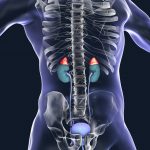Pelvic Pain in Endometriosis: Effects of Potentized Homeopathic Estrogen
Student Scholarship – Honorable Mention Research Review
Ashley Greene
Lauren Hacker, ND
Meryl McBride
Kris Somol, ND
Endometriosis is a chronic condition with limited options for treatment in the allopathic community. In general, naturopathic modalities, including homeopathy, tend to be used as part of an individualized approach to patients, which can lead to challenges in creating reproducible double-blind trials – a component of evidence-informed practice. This article provides a critical literature review of the addition of potentized homeopathic 17-beta estradiol to established palliative treatment plans aimed at reducing pelvic pain in women diagnosed with deeply infiltrating endometriosis.1 Our review included a PubMed search for clinical trials that focused on the use of standardized homeopathy as a complementary treatment for endometriosis-associated pelvic pain (EAPP). This article will focus on one particular study that emerged during our search. The controlled trial’s innovative design was able to establish a higher level of evidence compared to others, while also utilizing a modality that relies on individual experience and using keynote-related secondary inclusion criteria that respects the practice of homeopathy.
Pathogenesis, Prevalence, & Pain
Endometriosis is a chronic condition defined by the deposition of endometrial tissue outside of the endometrial cavity.2 It is considered a benign inflammatory disease that is dependent on estrogen and which affects premenarcheal, reproductive, and postmenopausal women.3 In the United States, endometriosis is a major reason for hospitalizations and procedures such as ovariectomies and hysterectomies.4 In 2009 the total annual healthcare cost for treatment and management of endometriosis was roughly $69.4 billion.4 A study published in 2018 showed a mean healthcare cost of over $14 000 annually for women with endometriosis, 3 times the healthcare costs of women without endometriosis.5
The molecular hallmarks of endometriosis include genetic susceptibility, inflammation, estrogen dependence, and progesterone resistance.4 Genetic susceptibility and inflammation combine to promote the deposition of endometrial lesions that contain both estrogen receptors and aromatase enzymes responsible for converting androgens to estrogens. This combination fuels local estrogen activity and production that continues to stimulate the growth of the lesions and perpetuate the cycle. Interestingly, it has been demonstrated that while there are no significant levels of estradiol in peripheral blood across affected populations, the estradiol levels in menstrual blood in women with endometriosis are the second highest, following adenomyosis.6 Although endometriosis is estimated to affect 6-10% of women, 35-50% of women experiencing pelvic pain and/or infertility are predicted to have endometriosis.4
Pain is the primary symptom in endometriosis, and it often continues after treatment.7 Several mechanisms underlying endometriosis-associated pain have been revealed, including inflammation, nociception, endocrine changes, and altered peripheral and central nervous system processing. Pain in endometriosis is frequently accompanied by fatigue and psychological distress, which in turn can exacerbate the physical pain.7 The peritoneal fluid of women with endometriosis has been found to contain high levels of nerve growth factor (NGF), a key player in nerve development.7 Additional neurotrophins have also been detected, such as brain-derived neurotrophic factor (BDNF), suggesting a role for these neurotrophins in the modulation of endometriosis-associated innervation and related pain.8-10 Estrogens can upregulate NGF, vascular endothelial growth factor (VEGF), and BDNF, supporting a link between estrogens and neuroangiogenesis.11 Although preliminary data suggest a link between elevated NGF or BDNF and endometriosis-associated pain, it is important to note that a clinical correlation between pain severity and high levels of these neurotrophins is still being researched.9,10,12
Clinical Challenges & Treatment
Endometriosis currently presents several challenges to clinical medicine due to the difficulty in clearly distinguishing its prevalence, symptomatology, and successful treatment methods. The current conventional medical treatment options for endometriosis-related pelvic pain depends on severity of symptoms. The first-line treatment for mild-to-moderate symptoms includes a combination therapy of non-steroidal anti-inflammatory drugs (NSAIDs) and hormonal contraceptives. If relief is not achieved after 3-4 months of an initial regimen, patients are usually switched to a different combination of NSAIDs and hormonal contraceptive. For severe symptoms, patients complete a trial of gonadotropin-releasing hormone (GnRH) agonists with add-back hormonal therapy; laparoscopy may also be used for diagnosis and guiding treatment.3
The call to find an affordable and effective treatment, that is also the least harmful and uses the least force, has long been answered by naturopathic doctors. Naturopathic treatment modalities for endometriosis are great in number, including but not limited to: botanical medicine, hydrotherapy, abdominal massage, constitutional homeopathy, and visceral manipulation. Although the trial reviewed in this article deviates from a key tenet of homeopathic medicine – treating the whole person with a remedy that is individual to her physical, mental, emotional, and spiritual state – it does uphold other key homeopathic principles, such as “like cures like,” the minimal dose, and the use of a single remedy to achieve effective results.
The Study
A PubMed database was searched using the MeSH terms “homeopathy” and “gynecology.” The filters included Article Types: Clinical Trials; Publication Dates: 10 years; Species Studied: Human; and results were filtered through Bastyr University’s “free full texts.” This search yielded 18 results. These results were narrowed down to those that were randomized, double-blinded, placebo-controlled, and which used living persons (as opposed to in-vivo studies). Based on its dynamic research design and the strength of its conclusions, Teixeira et al’s 2017 trial evaluating potentized 17-beta estradiol’s effect on pelvic pain was chosen.1
Methods
Teixeira’s trial recruited reproductive-aged Brazilian females between the ages of 18 and 45 who had been previously diagnosed with deeply infiltrating endometriosis. (See Table 1 for inclusion criteria.) The researchers used a relevant subject population, given that most diagnoses of endometriosis occur in women aged 15-44 years old.13 The trial was randomized using a random number generator performed by an independent researcher, and both patients and physicians were blinded; no further process regarding randomization or full allocation concealment is discussed in their article. Treatment and placebo groups were similar in age, use of concomitant therapies, general and mental health, and vitality. These groups differed slightly in terms of their primary site of endometriotic lesions and their beginning pain scores (the placebo group experienced less pain and showed lower scores).
Table 1. Study Inclusion Criteria1
| Primary inclusion criteria:
diagnosis-related |
|
| Secondary inclusion criteria: symptom-related
(Symptoms reflected pathogenetic effects of estrogen and were also keynotes of the remedy) |
|
| Participants |
|
(MRI = magnetic resonance imaging; TVU = transvaginal ultrasound; EAPP = endometriosis-associated pelvic pain; VAS = Visual Analog Scale; NSAIDs = non-steroidal anti-inflammatory drugs)
Fifty patients were randomized into either placebo or intervention group using homeopathic potentized 17-beta-estradiol mixed into lactose; this was delivered as liquid drops at increasing potencies of 12cH, 18cH, and 24cH. Doses were given at 8-week intervals, for a period of 24 weeks. The placebo was given in an identical dropper bottle that contained a hydro-alcoholic solution. Neither group was allowed to discontinue any concomitant therapy they had been using prior to the start of this trial. The outcome of the study was based on changes in severity of endometriosis-associated pelvic pain (EAPP) and quality of life as determined by the patient’s discretion, using a visual analog scale (VAS) (range 0-50 for global score; 10 points for each category). The subjects graded their pain at the beginning of the study and again at 24 weeks in regards to dysmenorrhea, non-cyclic pelvic pain, deep dyspareunia, and cyclic urinary and bowel pains.1 (See Table 2 for detailed results.)
Outcome
Over the 24-week period, the group receiving potentized estrogen experienced a significant reduction in endometriosis-associated pelvic pain, based on VAS global scores (12.82-point reduction from baseline). The placebo group did not show any significant change in VAS scores. The intervention group also showed significant reductions in dysmenorrhea, non-cyclic pelvic pain, and cyclic bowel pain.1
Adverse events were minimal and included only 1 patient withdrawal from the intervention group due to spotting. Four patients experienced possibly-related adverse events of nasopharyngitis, leucorrhea, and diarrhea. However, these adverse events were slight compared to the placebo group.1
Table 2. Study Results1
|
Primary outcome measures: Endometriosis-Associated Pelvic Pain (EAPP) |
Using EAPP VAS global score (range 0-50), the potentized estrogen group experienced a clinically significant reduction of 12.82 points on the EAPP global score (95% CI 6.74-18.89; p<0.001) from baseline EAPP global scores of 33.7 +/- 8.5. The placebo group did not show any significant change.
Evaluating EAPP VAS partial scores (range 0-10) using ITT analysis at 24 wk from baseline (with similar results on PP analysis), placebo was associated with no significant changes.
Potentized estrogen was associated with reduction of the partial scores in:
|
(ITT analysis = Intention to Treat analysis; PP analysis = Per-protocol analysis; MD = mean deviation]
There are multiple aspects of this study that are exceptional, especially given the difficulty in randomizing a modality such as homeopathy. This barrier was overcome in part by having secondary inclusion criteria that related to homeopathic estrogen; in other words, the individuals who were chosen to participate displayed characteristics that reflected the keynotes of the remedy. These keynote criteria for 17-beta estradiol included co-symptoms such as anxiety, depression, insomnia, migraines, and constipation. The use of these secondary criteria reflects the efficacy of this trial in determining the effectiveness of homeopathic medicines.
Discussion
The study examined in this review established the efficacy of potentized homeopathic estrogen for the symptomatic relief of pelvic pain associated with endometriosis. The outcome of the study was statistically significant, reflecting overall improvement in both pain and quality-of-life scores. Utilizing homeopathy as a treatment modality offers the benefits of being accessible and affordable compared to more mainstream treatments.
The use of potentized homeopathic estrogen in addition to established palliative treatments for EAPP outlined in this study upholds several naturopathic principles, including: tolle totum, primum non nocere, and vis medicatrix naturae. Through the use of like cures like, homeopathic estrogen allows for practitioners to treat one of the primary causes of endometriosis: an excess of estrogen. Furthermore, it upholds the idea of first do no harm by utilizing a method and medicine of least force and minimal adverse events. Using homeopathic estrogen in this way also recognizes and works with the self-healing intelligence of the body. The utilization of homeopathic estrogen outlined in this study is accessible to experts and beginner practitioners alike. Naturopathic doctors are apt to use this methodology.
The success of this trial also compels further research. For example, what is the effectiveness of potentized estrogen without concomitant therapy, and what would be the outcomes in a larger population study or longitudinal study? Other studies of interest would include replicating this study’s design to explore alternative homeopathic remedies for other reproductive and urologic conditions; examining the long-term effects of homeopathic treatment on pain scores; and assessing the ability of homeopathic estrogen to potentially delay surgical intervention in patients with chronic endometriosis-associated pain.
Conclusion
The allopathic standard of care includes few options for the treatment of endometriosis, and research is lacking that compares the efficacy of one treatment over another.2 Conventional treatments include the use of NSAIDs, hormonal contraceptives, GnRH agonists, and aromatase inhibitors, all of which are palliative options. Many women with endometriosis undergo hysterectomies due to the associated chronic pain and reduced quality of life. These research results suggest another treatment that can be used concomitantly with the palliative care, thereby providing additional relief and ideally preventing or delaying surgical intervention.1
Homeopathy, in contrast to these conventional therapies for endometriosis, comes with minimal risk of adverse effects; the worst possible outcomes are either no effect or symptoms reflective of proving the remedy, which are reversible upon discontinuation. Along with reduced risk of adverse events, benefits of homeopathic treatment include cost savings and promising possibilities for future research. The clinical question of how homeopathy can be used to treat or assist in treating endometriosis has just begun to be answered; further research should look at alternative remedies for treatment, the effectiveness of homeopathic remedies without concomitant use of possibly suppressive treatments (such as NSAIDs), and long-term effects of homeopathy for preventing hysterectomies and improving long-term quality of life in patients suffering from endometriosis.
References:
- Teixeira MZ, Podgaec S, Baracat EC. Protocol of randomized controlled trial of potentized estrogen in homeopathic treatment of chronic pelvic pain associated with endometriosis. 2016;105(3):240-249.
- Schenken RS. Endometriosis: Treatment of pelvic pain. 2017. UpToDate. Available at: https://www.uptodate.com/contents/endometriosis-treatment-of-pelvic-pain?source=related_link. Accessed May 1, 2018.
- Schenken RS. Endometriosis: Pathogenesis, clinical features, and diagnosis. 2018. UpToDate. Available at: https://www.uptodate.com/contents/endometriosis-pathogenesis-clinical-features-and-diagnosis. Accessed May 1, 2018.
- Burney RO, Giudice LC. Pathogenesis and pathophysiology of endometriosis. Fertil Steril. 2012;98(3):511-519.
- Soliman AM, Surrey E, Bonafede M, et al. Real-World Evaluation of Direct and Indirect Economic Burden Among Endometriosis Patients in the United States. Adv Ther. 2018;35(3):408-423.
- Kitawaki J, Kado N, Ishihara H, et al. Endometriosis: the pathophysiology as an estrogen-dependent disease. J Steroid Biochem Mol Biol. 2002;83(1-5):149-155.
- Morotti M, Vincent K, Becker CM. Mechanisms of pain in endometriosis. Eur J Obstet Gynecol Reprod Biol. 2017;209:8-13.
- Barcena de Arellano ML, Arnold J, Vercellino F, et al. Overexpression of nerve growth factor in peritoneal fluid from women with endometriosis may promote neurite outgrowth in endometriotic lesions. Fertil Steril. 2011;95(3):1123-1126.
- Ding S, Zhu T, Tian Y, et al. Role of Brain-Derived Neurotrophic Factor in Endometriosis Pain. Reprod Sci. 2018;25(7):1045-1057.
- Rocha AL, Vieira EL, Ferreira MC, et al. Plasma brain-derived neurotrophic factor in women with pelvic pain: a potential biomarker for endometriosis? Biomark Med. 2017;11(4):313-317.
- Morotti M, Vincent K, Brawn J, et al. Peripheral changes in endometriosis-associated pain. Hum Reprod Update. 2014;20(5):717-736.
- Kajitani T, Maruyama T, Asada H, et al. Possible involvement of nerve growth factor in dysmenorrhea and dyspareunia associated with endometriosis. Endocr J. 2013;60(10):1155-1164.
- Cramer DW, Missmer SA. The epidemiology of endometriosis. Ann N Y Acad Sci. 2002;955:11-22; discussion 34-6, 396-406.
 Ashley Greene is a 4th-year naturopathic student at Bastyr University in Seattle. She previously attended the FL State University and graduated with a BA in International Affairs and a minor in French. Ashley’s clinical interests include care for underserved populations and utilizing evidence-informed methods to bridge traditional naturopathic medicine and conventional care. Additionally, she has served for 3 years on the leadership team for Revival: Restore the Vis, a nature-based retreat in North Bend, WA, that connects the hearts of naturopathic students and doctors to the roots of our medicine.
Ashley Greene is a 4th-year naturopathic student at Bastyr University in Seattle. She previously attended the FL State University and graduated with a BA in International Affairs and a minor in French. Ashley’s clinical interests include care for underserved populations and utilizing evidence-informed methods to bridge traditional naturopathic medicine and conventional care. Additionally, she has served for 3 years on the leadership team for Revival: Restore the Vis, a nature-based retreat in North Bend, WA, that connects the hearts of naturopathic students and doctors to the roots of our medicine.
***
 Lauren Hacker, ND, was a 4th-year naturopathic student when she wrote this article. She graduated from Bastyr University in June 2019. As of November 2019, Lauren began practicing at Denver Naturopathic Clinic in her home state of CO, focusing on women’s health. She is enthusiastic about creating connected communities for both patients and doctors. She has previously served on the leadership team for Revival: Restore the Vis and as Secretary for the Association of Naturopathic ReVitalization (ANR). Lauren received her BA in English, with a minor in chemistry, from Western CO University in 2012. Prior to attending naturopathic school, Lauren worked in experiential education.
Lauren Hacker, ND, was a 4th-year naturopathic student when she wrote this article. She graduated from Bastyr University in June 2019. As of November 2019, Lauren began practicing at Denver Naturopathic Clinic in her home state of CO, focusing on women’s health. She is enthusiastic about creating connected communities for both patients and doctors. She has previously served on the leadership team for Revival: Restore the Vis and as Secretary for the Association of Naturopathic ReVitalization (ANR). Lauren received her BA in English, with a minor in chemistry, from Western CO University in 2012. Prior to attending naturopathic school, Lauren worked in experiential education.
***
 Meryl McBride is a 4th-year naturopathic student at Bastyr University. Meryl received her undergraduate from the University of AZ with a BS in ecology and evolutionary biology, and minors in mathematics and English literature. At the university she worked under Dr Peter Chesson researching desert ecology, focusing on the effects of invasive species on native habitats. She utilizes her ecology education today in appreciating the influence environmental and biological diversity has on physical health. Outside of school, Meryl relishes growing her own food, dynamic movement, and, most recently, snuggling with her newborn daughter.
Meryl McBride is a 4th-year naturopathic student at Bastyr University. Meryl received her undergraduate from the University of AZ with a BS in ecology and evolutionary biology, and minors in mathematics and English literature. At the university she worked under Dr Peter Chesson researching desert ecology, focusing on the effects of invasive species on native habitats. She utilizes her ecology education today in appreciating the influence environmental and biological diversity has on physical health. Outside of school, Meryl relishes growing her own food, dynamic movement, and, most recently, snuggling with her newborn daughter.
***
 Kris Somol, ND, is an adjunct academic and clinical faculty member at Bastyr Center for Natural Health in Seattle, WA; she has also been practicing primary-care family medicine since 2005. Dr Somol has spent 20 years in the healing profession and 10 years as a public educator on botanical medicine. She is especially focused on preventive care and sees a wide range of acute and chronic conditions. Since 2008, Dr Somol has lectured on asthma in adolescence, food allergies and food allergy testing, and updates in women’s health issues at various medical conferences. She has also written articles for the Seattle Times on women’s health.
Kris Somol, ND, is an adjunct academic and clinical faculty member at Bastyr Center for Natural Health in Seattle, WA; she has also been practicing primary-care family medicine since 2005. Dr Somol has spent 20 years in the healing profession and 10 years as a public educator on botanical medicine. She is especially focused on preventive care and sees a wide range of acute and chronic conditions. Since 2008, Dr Somol has lectured on asthma in adolescence, food allergies and food allergy testing, and updates in women’s health issues at various medical conferences. She has also written articles for the Seattle Times on women’s health.










